In our preschool lesson planning resources, we’re bringing the magic of the ocean to the classroom with an exciting ocean sensory bin activity. Imagine the joy on your preschoolers’ faces as they use pipettes to drop dyed vinegar into a baking soda-filled sensory bin, revealing hidden treasures like seashells, starfish, and dried sea urchins.
This engaging hands-on activity not only stimulates their senses but also introduces them to basic science principles in a fun and interactive way. Get ready to explore the wonders of the ocean right from your classroom!
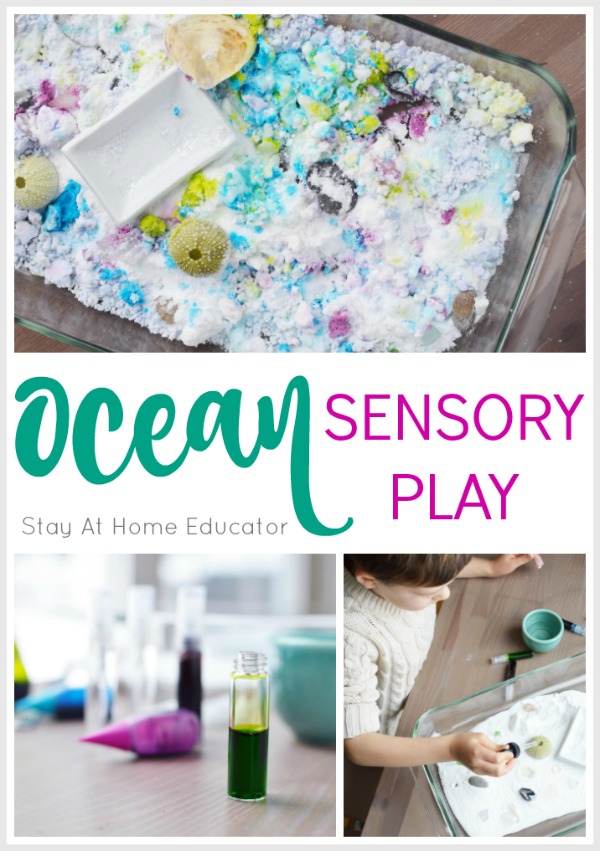
This ocean sensory bin provides a fantastic opportunity for preschoolers to develop fine motor skills, as they carefully navigate pipettes to drop vinegar into the bin. The reactions between the vinegar and baking soda create a fizzing sensation that mimics the sounds of waves, adding an extra layer of fun to the activity.
More than just play, this unique approach to learning helps foster their curiosity and understanding of the world around them.
As they uncover seashells, starfish, and dried sea urchins, they can create their own ocean stories and chatter to one another about facts they have learning about ocean animals. You can get our ocean animal fact cards in our Ocean Activity Pack for Preschoolers.
This not only enriches their playtime but also enhances their language skills and creativity. So, why wait? Let’s make learning a joyous adventure with our ocean sensory bin!
This ocean sensory bin pairs wonderfully with our Ocean Waves Sensory Bottle, too.
Why a Baking Soda and Vinegar Ocean Sensory Bin
We have to be deliberate about what kind of activities we include in our ocean preschool lesson plans. Here is why I like this sensory bin for my preschoolers.
- The visual stimulus of the chemical reaction.
- The sound of the foaming.
- The scent of essential oils (and not vinegar).
- The textures of real ocean materials nestled within the sensory bin.
All of these things combined creates a wonderful playful learning experience, which is always a top priority when doing hands on activities.
Baking Soda & Vinegar Sensory Bin for Ocean Theme
The ocean sensory bin helps preschoolers enhance their fine motor skills as they use pipettes to add vinegar. The vinegar reacts with baking soda, creating a fizzing wave-like effect, making learning fun and fostering their curiosity about the world.
Materials
- Baking soda
- White vinegar
- Food coloring or liquid watercolor
- Essential oils
- Small, glass spray bottles (one for each color)
- Pipettes or eye droppers
- Natural ocean materials, such as sea shells, rocks, etc.
- White, iridescent glitter (because the ocean is sparkly)
This post may contain affiliate links, which means that at no cost to you, I may earn a small sum if you click through and make a purchase.
- Washable-washes from more fabrics and surface with simple soap and water, may stain some porous…
- AP certified, conforms to ASTM D 4236, Safe and non-toxic
- Made in USA
- Accurate Scale: Each dropper has a clear scale: 1ml, 2ml, 3ml, 4ml, 5ml. The scales are engraved,…
- Colorful Design: The dropper has 7 bright colors: red, green, rose, purple, light blue, yellow and…
- Safe Material: The silicone dropper is made of food grade silicone, safe and tasteless. The baby can…
- Iridescent Glitter. 1 Pound Bottle. Fine Glitter
- Versatile Glitter for All Your Crafting Needs: Enhance your craft projects with our high-quality…
- Generous 1 lb Size for Multiple Projects: Each bottle contains 1 pound of sparkling glitter,…
The Set-Up
Pour the baking soda into the sensory bin, enough to thoroughly cover the entire bin. You may need to use an entire box, depending on the size of your bin.
Fill each spray bottle with vinegar about ¾ of the way full. Add a few drops of food color or liquid watercolor, and then add a few drops of essential oils to each bottle.
Since we are using vinegar, you’ll want to use the stronger scents of essential oils. My preferences are orange, lemon and peppermint. These are also the same essential oils I like to use in my famous softest-ever play dough recipe.
What can I say? It’s summertime! And to me, summertime calls for citrus and mint!
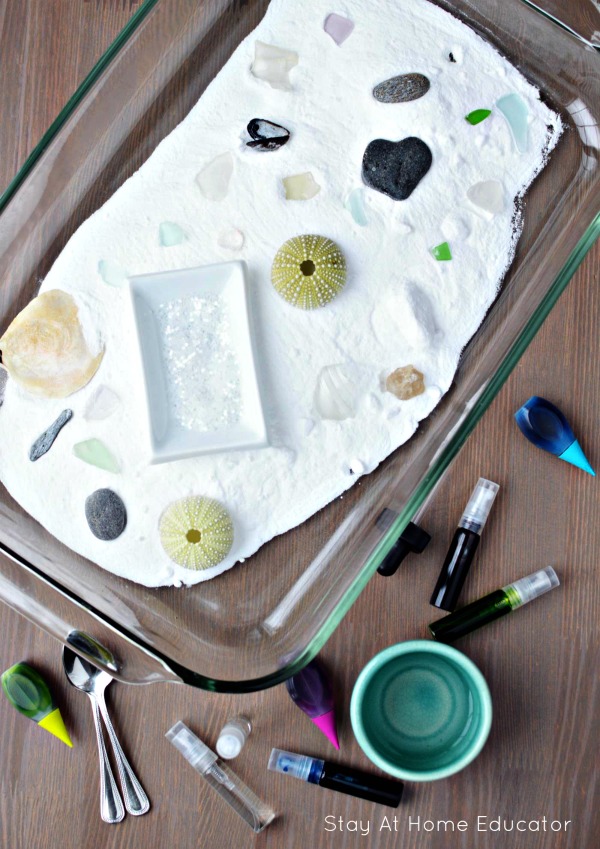
Ocean Sensory Play
I invited my preschooler to join me at our new ocean sensory bin. He loved the colors to choose from in the bottles. But it doesn’t take a preschooler long to figure out what to do. So, he grabbed a spray bottle and tried spraying the vinegar into the bin.
Now, the glass spray bottles were difficult for my preschooler. The nozzle was a little stiff and he had to hold the bottle with one hand while using his entire palm to push down on the top.
This may have been a good exercise in coordination, fine motor skills, and hand strength, but he quickly grew tired, so we opted to use an eye dropper instead.
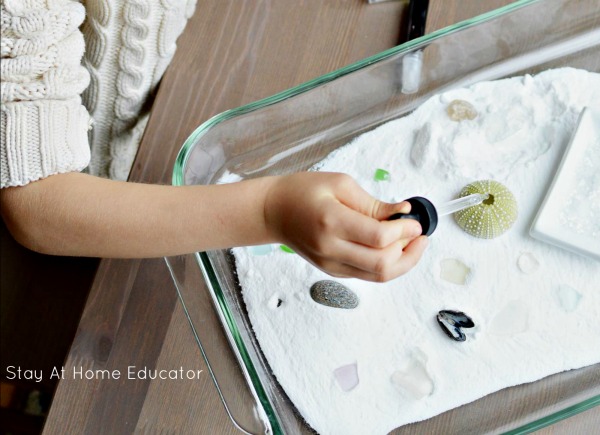
You may find your preschooler loves the spray bottles and already has the hand strength to use them. So try it out, because it’s a fun change from the predictable eyedropper or pipette.
My preschooler’s favorite part of the ocean sensory bin was the sea urchin skeleton. (If you don’t have a few of these for your ocean theme, they are well worth the expense).
It took extra coordination to drop the vinegar into the tiny hole at the top, and my preschooler challenged himself to fill it with enough vinegar to make it bubble and foam out the top like a volcano. Through some trial and error, we learned that we needed to fill the skeleton with a lot of baking soda to make it foam and overflow.
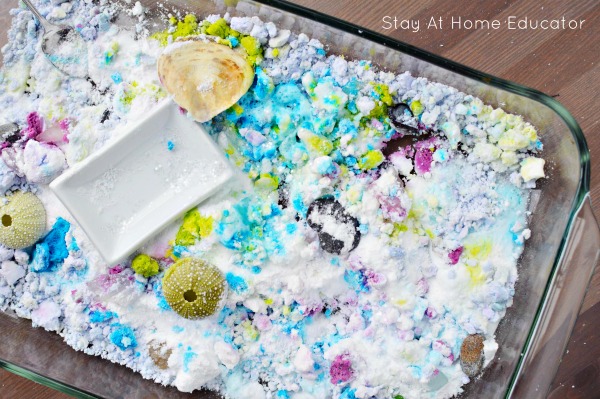
But it was such a surprise to uncover the smaller seashells and rocks as he used the eyedropper to drip the vinegar solution onto the baking soda, and the mix of colors was fun, too. While it wasn’t my intention, we got in a little learning about color theory, too.
By the end, my preschooler had enjoyed a good half an hour or more of fine motor work with the eyedropper, and the sensory bin smelled lovely. (Remember the orange, lemon, and peppermint?)
In addition, I got to witness my preschoolers talking about the ocean creatures and ocean life, and the baking soda and vinegar reaction never stopping being fascinating to the preschoolers. This is definitely a sensory activity we will keep in our ocean themed activities.
Science Sensory Bins for Preschool
I am a firm believer that while sensory activities like these are wonderful for keeping the chidlren busy, preschoolers benefit most from them when the supervising adult engages them in “science talk”.
Here are a few questions to ask your preschooler are he explores the materials in the ocean sensory bin:
- What does it sound like with the baking soda and vinegar start to react and foam?
- What happens when the different colors are dripped in the same place?
- How could you make color…?
- What happens when you squirt a lot of vinegar in one spot?
- What happens when you only squirt a little?
- How can you make the bin bubble a lot?
- What kinds of ocean things have you found in the bin? Can you tell me about them?
- What kinds of animals might have lived in the seashells in our sensory bin?
You get the picture.
The point is to talk to your preschooler about what he is doing as he explores the sensory bin. Invite him to engage with you in the language that is associated with a science activity like this one, and don’t be afraid to teach new vocabulary or extra big words.
Language development is a predictor of reading success, so the more you can get your preschooler thinking and talking about something like a sensory bin, the better off they will be academically!
Children’s Books About the Ocean
There are numerous children’s books about the ocean that both entertain and educate. These children’s books about ocean life are sure to captivate young readers with their stories, but also foster understanding about marine life and the importance of ocean conservation.
- Smithers, Anna (Author)
- English (Publication Language)
- 32 Pages – 09/12/2023 (Publication Date) – Orange Lotus Publishing (Publisher)
- Pritchard, Natalie (Author)
- English (Publication Language)
- 40 Pages – 10/15/2019 (Publication Date) – Independently published (Publisher)
- Allieri, Patricia (Author)
- English (Publication Language)
- 39 Pages – 05/03/2023 (Publication Date) – Aqua Kids Books (Publisher)
- Hardcover Book
- English (Publication Language)
- 128 Pages – 09/14/2021 (Publication Date) – Kidsbooks Publishing (Publisher)
- Costanzo, Beth (Author)
- English (Publication Language)
- 36 Pages – 11/01/2020 (Publication Date) – Puppy Dogs & Ice Cream (Publisher)
More Ocean Sensory Bins
Ocean sensory bins are a popular hands-on activity that offers children a fun and interactive way to explore ocean themes and develop their creativity. With simple materials, these sensory bins can provide hours of entertaining and educational play, fostering fine motor skills, language skills, and a deeper understanding of the world around them
- Ocean Animal Sensory Bin
- Name Spelling Ocean Sensory Bin
- Sensory Table: Ocean Small World Play
- Under the Sea Sensory Bin
- Sand & Water Ocean Sensory Bin
More Preschool Activities About Ocean Animals
Preschool activities about ocean animals, like creating underwater creatures using craft materials, can help children develop fine motor skills while learning about marine life. Interactive games and activities stimulate their cognitive skills, enhance their knowledge about different ocean species, and provide an enjoyable learning experience.
Try some of these fun ocean activities for preschoolers
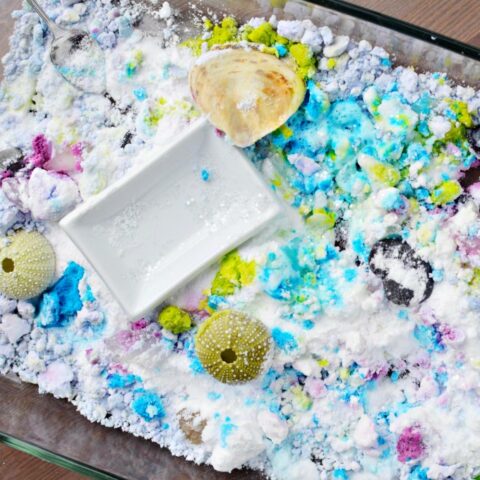
Baking Soda and Vinegar Ocean Sensory Bin
This activity is science meets sensory bin!
Simple baking soda and vinegar create awesome reactions that mimic ocean waves.
Your preschoolers will delight every time they add some vinegar into the bin.
They will discover hidden treasures of the ocean as they explore.
This ocean sensory bin offers excellent fine motor skills practice and is oh so much FUN for your little scientists!
Materials
- Baking soda
- White vinegar
- Food coloring or liquid watercolor
- Essential oils
- Small, glass spray bottles (one for each color)
- Pipettes or eye droppers
- Natural ocean materials, such as seashells, rocks, etc.
- White, iridescent glitter (because the ocean is sparkly)
Instructions
- Pour the baking soda into the sensory bin, enough to thoroughly cover the entire bin. Depending on the size of your bin, you may need to use an entire box.
- Fill each spray bottle with vinegar about ¾ of the way full.
- Add a few drops of food color or liquid watercolor.
- Add a few drops of essential oils to each bottle, using scents of your choice.
- Invite your preschoolers to try a spray bottle or eye dropper. The eye droppers will be easier for little hands than the spray bottles.
- Encourage your preschoolers to try spraying a variety of colors into the baking soda.
- Observe and listen as the baking soda and vinegar react together and make "waves".
- Ask "science-based" questions to get the kids to think about what is happening as they play and try different things. Verbalizing some of your scientific observations is a good way to model inquiry and problem-solving skills.
- Let the children explore and have fun for as long as they would like. Prepare to be as thrilled as the kids every time the baking soda and vinegar react!
Notes
Here are some possible guiding questions to use with your preschoolers during this activity:
- What does it sound like with the baking soda and vinegar start to react and foam?
- What happens when the different colors are dripped in the same place?
- How could you make color…?
- What happens when you squirt a lot of vinegar in one spot?
- What happens when you only squirt a little?
- How can you make the bin bubble a lot?
- What kinds of ocean things have you found in the bin? Can you tell me about them?
- What kinds of animals might have lived in the seashells in our sensory bin?
Recommended Products
As an Amazon Associate and member of other affiliate programs, I earn from qualifying purchases.

I’m Sarah, an educator turned stay-at-home-mama of five! I’m the owner and creator of Stay At Home Educator, a website about intentional teaching and purposeful learning in the early childhood years. I’ve taught a range of levels, from preschool to college and a little bit of everything in between. Right now my focus is teaching my children and running a preschool from my home. Credentials include: Bachelors in Art, Masters in Curriculum and Instruction.
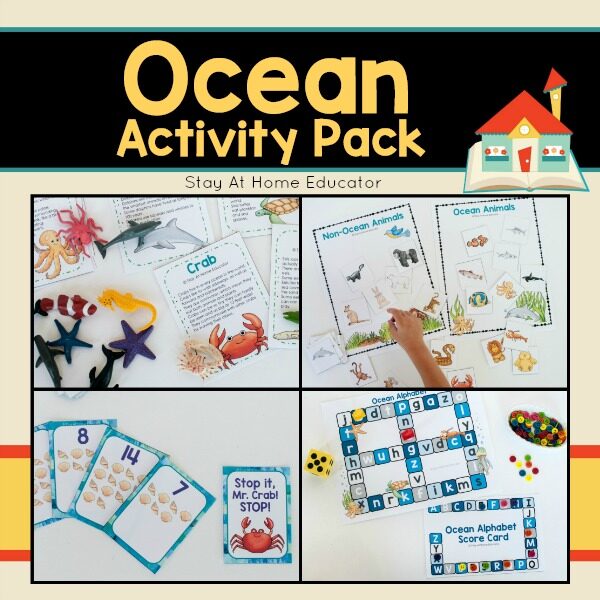












Awesome for special needs students. We use differentiated instruction model via a multi-sensory approach for all of our lessons. Thanks for another great idea.